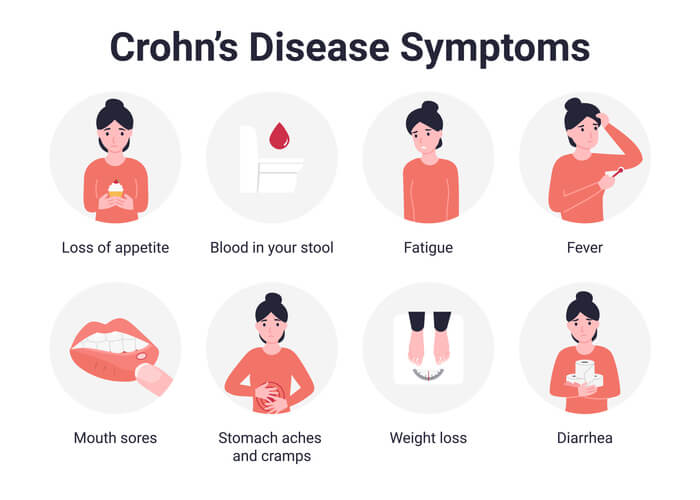Crohn’s disease is a highly uncomfortable condition that causes chronic inflammation of the entire gastrointestinal tract (GI). It is part of a group of GI issues called inflammatory bowel diseases (IBD).
IBD is different than irritable bowel syndrome (IBS) — a disorder that affects the contractions of muscles in the bowel. While IBS is potentially distressing for a patient, the Social Security Administration (SSA) does not consider it a disability.
However, with Crohn’s disease/IBD, an individual dealing with this condition may potentially qualify for benefits if they’re unable to work. But since there’s no single test that definitively proves an individual has Crohn’s, there are multiple steps to getting approval.
Read on to learn how patients with Crohn’s disease may qualify for Social Security disability (SSD) benefits.
What Are the Symptoms of Crohn’s Disease?
Even though Crohn’s disease affects as many as 780,000 Americans, the exact cause is unknown. However, scientists believe genetics, the environment, and a patient’s own immune system play a large role.

With Crohn’s disease, affected individuals may experience issues anywhere along the GI tract — from the mouth to the anus. Most commonly, however, it manifests in the large and small intestines, and specifically in the ileum (the lower small intestine). The ileum links to the colon, and this connection is responsible for many of the uncomfortable side effects of Crohn’s.
Irritation, inflammation, and complications of sores and bowel obstructions mean this is not a fun condition with which to contend. When flare-ups happen — which may last weeks or even months — symptoms may include severe diarrhea and abdominal pain/cramping.
Other indicators may include:
- Rectal bleeding
- Fever
- Persistent vomiting
- Fatigue
- Loss of appetite
- Weight loss
Interestingly, because Crohn’s stems from an immune system overreaction, some patients also experience issues with their eyes, skin, and joints.
With the various ways Crohn’s disease may present itself, it’s easy to see how a multifaceted diagnosis is necessary. It’s also easy to see how anyone living with all these symptoms might really struggle to keep working.
In mild cases, it might be manageable. Especially since the American Disabilities Act (ADA) issued workplace guidelines for Crohn’s patients to help make this possible, such as better access to restrooms or the option to work from home.
But individuals with more severe issues would be hard-pressed to just keep taking bathroom breaks during work. Enter the need for disability coverage.
What Evidence is Required to Get Disability for a Crohn’s Disease Diagnosis?
The SSA considers Crohn’s disease a disability because it falls within the scope of inflammatory bowel diseases. IBD appears in the SSA’s “Listing of Impairments” that may qualify for benefits — section 5.06 Inflammatory Bowel Disease.
To meet the SSA’s “Blue Book” definition of Crohn’s disease, however, applicants for SSD must supply evidence. That means documentation showing the patient’s results from endoscopy, biopsy, or other appropriate medical imaging or surgeries.
An applicant must show the SSA one the following when requesting disability benefits for Crohn’s:
A. Intestinal obstruction. Applicants must show presence of an obstruction in the small intestine or colon (not an adhesion). Said obstruction is confirmable by appropriate medical imaging, or a related hospitalization or surgery. It also must occur at least twice, 60 days apart within the same six-month period.
OR
B. Other Crohn’s-related complications. If an applicant cannot satisfy the “intestinal obstruction” requirement, they must show two of the following occurring within six months:
- Anemia with hemoglobin of less than 10.0 g/dL present at least 60 days apart in two separate blood tests.
- Serum albumin of 3.0 g/dL or less present at least 60 days apart in two separate blood tests.
- Painful abdominal mass palpable upon examination that isn’t responding to prescribed pain medication. Must be present a minimum of 60 days apart in at least two separate clinical evaluations.
- Perineal disease with a draining abscess or fistula that isn’t responding to prescribed pain medication. Must be present a minimum of 60 days apart in two separate doctor’s visits.
- Unintentional weight loss of at least 10% of patient’s baseline weight. Must be present during at least two separate evaluations a minimum of 60 days apart.
- Need for supplemental daily nutrition by feeding tube in the stomach, nose, or small intestine, or by chest catheter.
What if I Don’t Meet the IBD Criteria?
Individuals unable to qualify through the IBD criteria may still be eligible for disability if their weight loss is extreme. Applicants would need to prove their condition via the Blue Book section 5.08 Weight loss due to any digestive disorder. To qualify for this listing, the patient must show evidence of a digestive disorder as well as:
- Continued weight loss despite prescribed treatment.
- BMI of less than 17.50 calculated during at least two evaluations at minimum 60 days apart within a six-month period.
Additionally, sometimes patients are too sick to work but don’t meet the SSA’s disability requirements for IBD or weight loss. When that happens, they may ask the SSA to consider the case in relation to their Residual Functional Capacity (RFC). RFC is an assessment of how a medical condition may cause physical and mental limitations in a person’s work setting.
The SSA will look at an applicant through the lens of their RFC and how that would impact work ability. If the SSA determines that their symptoms preclude them from being able to work, then they will award disability benefits.
What Other Requirements Must I Meet to Receive Disability?
Regardless of how an applicant seeks disability — whether through an RFC or a Blue Book listing — there are other requirements.
Remember, Social Security Disability Insurance (SSDI) and Supplemental Security Income (SSI) benefits are not for short-term or partial disabilities. Non-medical eligibility requirements also include not being able to participate in substantial gainful activity (SGA) for 12 months. Applicants must not be working consistently if they hope to receive disability for Crohn’s disease.
Also, anyone applying for SSDI will have to show a previous work history. Typically, that means working at least five out of the last 10 years and paying into the SSA system. SSI applications necessitate demonstrations of very low income.
The bottom line is that there are many elements to getting a disability application through the system successfully. And with conditions like Crohn’s disease, proving that it warrants disability benefits is more challenging.
As a result, it may make sense to consult with a Social Security disability attorney. Especially considering that having a lawyer file your disability claim makes you three times more likely to get benefits. It’s a complicated process and you shouldn’t have to try to stomach it all alone!
Get Your Free Benefits Evaluation
Kimberly Dawn Neumann is a multi-published NYC-based magazine and book writer whose work has appeared in a wide variety of publications ranging from Forbes toCosmopolitan. She graduated summa cum laude from the University of Maryland, College of Journalism. For more, visit:www.KDNeumann.com, Instagram @dancerscribe, and Twitter/X @KimberlyNeumann.

